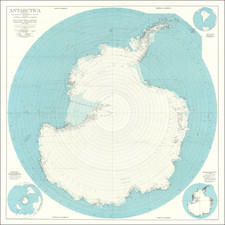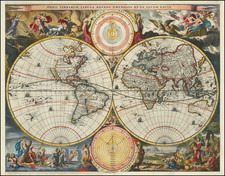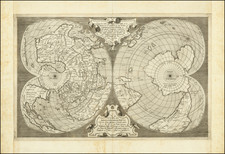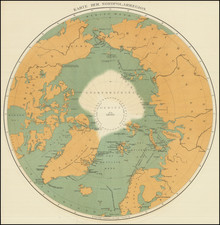Explaining Geography in all its Detail at the End of the Seventeenth Century
Fine example of two hemispheric maps from Pierre Moullart Sanson’s influential Introduction a la Geographie en Plusieurs Cartes, first published in 1681.
While the Introduction was published in several editions at the turn of the eighteenth-century, the book and its maps remain rare on the market today.
The first part of the textbook focused on representations of the world on various projections, allowing the reader to understand different groupings of continents and features. It is in this section that the two present maps belonged, showing the northern hemisphere on a concave projection and the hemisphere “superieur” (consisting of Europe, Western Asia, Northern Africa, and parts of the Americas) on a convex projection.
The maps of the Introduction were practically unique in adopting and juxtaposing these projections. At left is the concave northern hemisphere in “counterproof” as if viewed from the South Pole, making the geography appear in reverse. It includes an extensive, unnamed island between North America and Asia and California is shown as an island (see below).
The projection is explained in the note at the bottom of the map:
[The projection] supposes the eye of the one who describes the Boreal hemisphere is at the southern pole at the convexity of the globe, where he looks at all the terrestrial places by their base through the equator which serves as a plane, all the meridians are represented there by straight lines and the parallels by circles equally distant from each other and whose spaces are smaller towards the Boreal pole than towards the equator because they are farther from that which looks at or describes the figure.
At right is a convex projection, with the “eye being infinitely distant with respect to one of the poles.” As with the other map, it shows a possible Northwest Passage via what is today Canada. It also contains more information outside the map itself, including azimuths, equinoctials, and minutes of the horizon. Both maps would be used in conjunction with the text to master geographic concepts.
Pierre Moullart-Sanson took over the prominent Sanson geographic practice from his uncle, Guillaume, at the end of the seventeenth century. Guillaume, in turn, was the son of the famous Nicolas Sanson, who oversaw the ascendance of French cartography in the final decades of the seventeenth century.
Rarity
The map is very rare on the market. We note only 1 other example in AMPR in the past 30 years.
The popular misconception of California as an island can be found on European maps from the sixteenth through the eighteenth centuries. From its first portrayal on a printed map by Diego Gutiérrez, in 1562, California was shown as part of North America by mapmakers, including Gerardus Mercator and Abraham Ortelius. In the 1620s, however, it began to appear as an island in several sources. While most of these show the equivalent of the modern state of California separated from the continent, others, like a manuscript chart by Joao Teixeira Albernaz I (ca. 1632) now in the collection of the National Library of Brasil shows the entire western half of North Americas as an island.
The myth of California as an island was most likely the result of the travel account of Sebastian Vizcaino, who had been sent north up the shore of California in 1602. A Carmelite friar, Fray Antonio de la Ascensión, accompanied him. Ascension described the land as an island and around 1620 sketched maps to that effect. Normally, this information would have been reviewed and locked in the Spanish repository, the Casa de la Contratación. However, the manuscript maps were intercepted in the Atlantic by the Dutch, who took them to Amsterdam where they began to circulate. Ascensión also published descriptions of the insular geography in Juan Torquemada’s Monarquia Indiana (1613) (with the island details curtailed somewhat) and in his own Relación breve of ca. 1620.
The first known maps to show California as an island were on the title pages of Antonio de Herrera’s Descripción de las Indias Occidentales (1622) and Jacob le Maire's Spieghel Der Australische Navigatie (1622). Two early examples of larger maps are those by Abraham Goos (1624) and another by Henry Briggs, which was included in Samuel Purchas’ Hakluytus Posthumus or Purchas his Pilgrimes (1625). In addition to Briggs and Goos, prominent practitioners like Jan Jansson and Nicolas Sanson adopted the new island and the practice became commonplace. John Speed’s map (1626-7), based on Briggs’ work, is well known for being one of the first to depict an insular California.
The island of California became a fixture on mid- and late-seventeenth century maps. The island suggested possible links to the Northwest Passage, with rivers in the North American interior supposedly connecting to the sea between California and the mainland. Furthermore, Francis Drake had landed in northern California on his circumnavigation (1577-80) and an insular California suggested that Spanish power in the area could be questioned.
Not everyone was convinced, however. Father Eusebio Kino, after extensive travels in what is now California, Arizona, and northern Mexico concluded that the island was actually a peninsula and published a map refuting the claim (Paris, 1705). Another skeptic was Guillaume De L’Isle. In 1700, De L’Isle discussed “whether California is an Island or a part of the continent” with J. D. Cassini; the letter was published in 1715. After reviewing all the literature available to him in Paris, De L’Isle concluded that the evidence supporting an insular California was not trustworthy. He also cited more recent explorations by the Jesuits (including Kino) that disproved the island theory. Later, in his map of 1722 (Carte d’Amerique dressee pour l’usage du Roy), De L’Isle would abandon the island theory entirely.
Despite Kino’s and De L’Isle’s work, California as an island remained common on maps until the mid-eighteenth century. De L’Isle’s son-in-law, Philippe Buache, for example, remained an adherent of the island depiction for some time. Another believer was Herman Moll, who reported that California was unequivocally an island, for he had had sailors in his offices that claimed to have circumnavigated it. In the face of such skepticism, the King of Spain, Ferdinand VII, had to issue a decree in 1747 proclaiming California to be a peninsula connected to North America; the geographic chimera, no matter how appealing, was not to be suffered any longer, although a few final maps were printed with the lingering island.












![Карта Часовыхъ Поясовъ. [Map of Time Zones]](https://storage.googleapis.com/raremaps/img/small/95040.jpg)

